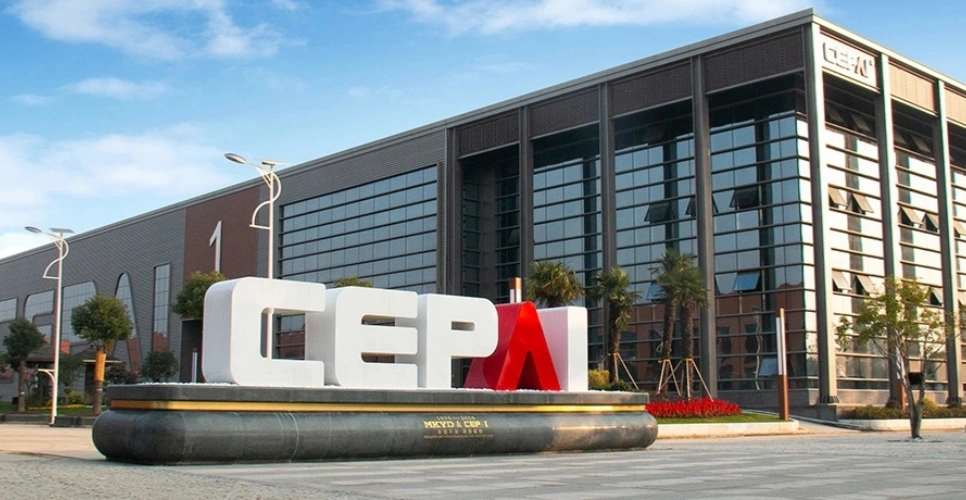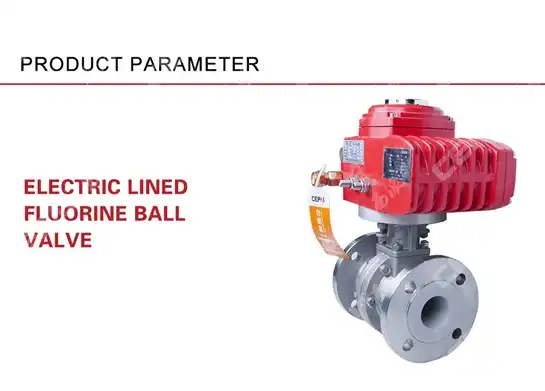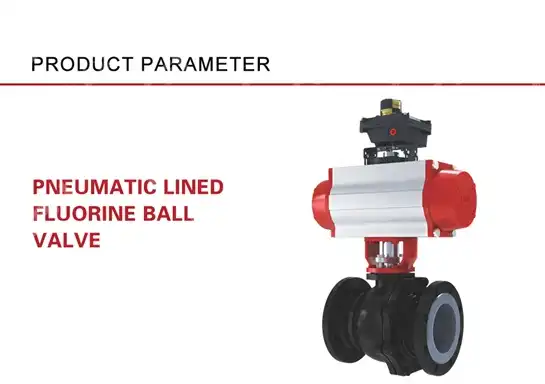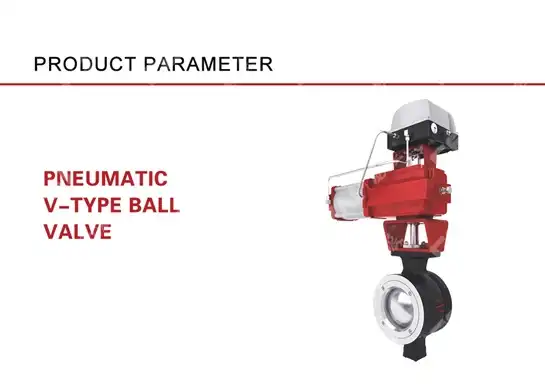Pneumatic vs. Electric Ball Valves: A Head-to-Head Comparison
Choosing between pneumatic and electric ball valves can make or break your industrial automation project. Picture this: your production line suddenly halts because the wrong valve actuator was selected, costing thousands in downtime. This comprehensive comparison of pneumatic ball valve technology versus electric alternatives will guide you through the critical decision factors, performance characteristics, and cost implications that directly impact your operational efficiency. Understanding these differences ensures you select the optimal pneumatic ball valve solution for your specific application requirements.
Understanding Pneumatic Ball Valve Technology and Operation
-
Core Operating Principles of Pneumatic Ball Valves
A pneumatic ball valve operates through compressed air pressure that drives an actuator mechanism to rotate the valve's internal ball element. The biggest difference between pneumatic actuated ball valves and electric ball valves is the power source: pneumatic valves use compressed air, while electric valves use electrical power. The pneumatic actuator converts compressed air energy into linear or rotary mechanical motion, providing the torque necessary to turn the ball valve through its quarter-turn operation cycle. This pneumatic ball valve system typically requires an air compressor, pressure regulators, and control solenoids to function effectively within industrial automation systems. The internal mechanism of a pneumatic ball valve consists of a hollow ball with a bore through its center, positioned between two seats within the valve body. When the pneumatic actuator receives a control signal, compressed air flows into the actuator cylinder, moving a piston that rotates the ball either 90 degrees to open or close the flow passage. This pneumatic ball valve design offers rapid response times, typically achieving full stroke operation in seconds. The simplicity of pneumatic systems makes them inherently reliable for applications requiring frequent cycling and harsh environmental conditions where electronic components might fail.

-
Advantages and Performance Characteristics
Pneumatic actuators are known for their high-speed operation and durability, making pneumatic ball valve systems particularly suitable for applications requiring rapid response and frequent operation cycles. The pneumatic ball valve offers exceptional speed advantages, with actuation times typically ranging from 1-5 seconds for full stroke operation, significantly faster than most electric alternatives. This speed characteristic proves invaluable in emergency shutdown applications, process control scenarios requiring quick response, and high-frequency cycling applications where productivity depends on valve operation speed. The inherent safety characteristics of pneumatic ball valve systems provide another significant advantage, particularly in hazardous environments. Since pneumatic actuators use compressed air rather than electrical power, they eliminate spark risks associated with electric actuators, making them ideal for explosive atmospheres and volatile chemical processing applications. Additionally, pneumatic ball valve systems demonstrate excellent performance in extreme temperatures where electronic components might malfunction, with operating ranges often extending from -40°F to +200°F without performance degradation. The fail-safe capability of pneumatic systems allows for spring-return operation during air supply loss, ensuring predictable valve position during emergencies.
Electric Ball Valve Systems and Their Applications
-
Electric Actuator Technology and Control Precision
Electric ball valve systems utilize motor-driven actuators that provide precise positioning control and feedback capabilities superior to pneumatic alternatives. Electric actuators offer precision control and ease of installation, making them particularly valuable in applications requiring exact flow modulation and process control. The electric ball valve actuator typically employs either AC or DC motors coupled with gear reduction mechanisms to provide the necessary torque for valve operation while maintaining precise positioning accuracy within fractions of a degree. The control sophistication available with electric ball valve systems far exceeds pneumatic alternatives, offering features such as variable speed control, programmable positioning, and integrated feedback systems. Modern electric actuators incorporate encoders, potentiometers, or resolvers that provide real-time position feedback, enabling closed-loop control systems that ensure accurate valve positioning regardless of system pressures or external forces. This electric ball valve precision proves essential in applications such as flow metering, blending operations, and processes requiring consistent flow rates where pneumatic ball valve systems might lack sufficient accuracy.
-
Integration Benefits and Automation Compatibility
Electric ball valve systems excel in integration with modern automation and control systems, offering superior communication capabilities and diagnostic features compared to pneumatic alternatives. The electric actuators can interface directly with industrial networks such as Modbus, Foundation Fieldbus, or Ethernet protocols, eliminating the need for additional signal conversion equipment required with pneumatic ball valve systems. This direct integration capability reduces installation complexity and enables advanced diagnostic monitoring, predictive maintenance scheduling, and remote operation capabilities that enhance overall system reliability and efficiency. The power requirements for electric ball valve operation often prove more convenient than pneumatic systems, particularly in facilities lacking adequate compressed air infrastructure. Electric actuators can operate from standard facility power supplies without requiring compressors, air treatment equipment, or distribution piping associated with pneumatic ball valve installations. However, electric systems require careful consideration of power consumption, particularly in battery-powered or remote applications where energy efficiency becomes crucial. The electric ball valve typically consumes power only during movement, making them energy-efficient for applications involving infrequent operation cycles.
Performance Comparison: Speed, Power, and Reliability
-
Speed and Response Time Analysis
Pneumatic valve actuators cycle much quicker than electric actuators, which can be beneficial or problematic. The pneumatic ball valve demonstrates superior speed characteristics, typically completing full stroke operations in 1-5 seconds compared to electric systems that may require 15-60 seconds for equivalent travel. This speed advantage stems from the instantaneous torque delivery of compressed air systems, where pneumatic ball valve actuators receive full power immediately upon signal activation. The rapid response capability makes pneumatic systems ideal for emergency shutdown applications, safety interlocks, and processes requiring quick isolation or flow diversion. However, the speed advantage of pneumatic ball valve systems can become problematic in applications requiring smooth, controlled transitions. The rapid actuation can cause water hammer effects in liquid systems or pressure surges that damage downstream equipment. Electric ball valve systems provide superior speed control, allowing for programmable acceleration and deceleration profiles that minimize system shock and extend equipment life. The variable speed capability of electric actuators enables optimization of operation speed for specific applications, balancing response time requirements with system protection needs.
-
Power Requirements and Infrastructure Considerations
The power infrastructure requirements differ significantly between pneumatic ball valve and electric systems, influencing installation costs and operational complexity. Pneumatic ball valve systems require compressed air infrastructure including compressors, air treatment equipment, distribution piping, and pressure regulation components. While individual pneumatic actuators consume no electrical power during operation, the supporting air compression systems typically require substantial electrical power, often making the overall system energy consumption higher than electric alternatives for intermittent duty applications. Electric ball valve systems eliminate compressed air infrastructure requirements but introduce electrical power distribution and control wiring considerations. The electric actuators require appropriately sized electrical supplies and may need explosion-proof enclosures in hazardous environments, increasing installation costs compared to pneumatic ball valve systems. However, electric systems offer superior energy efficiency for applications involving infrequent operation, consuming power only during movement periods while pneumatic systems require continuous compressor operation to maintain air pressure reserves.

Cost Analysis and Economic Considerations
-
Initial Investment and Installation Costs
The initial cost comparison between pneumatic ball valve and electric systems depends heavily on existing facility infrastructure and application requirements. Pneumatic ball valve systems typically demonstrate lower individual actuator costs, with basic pneumatic actuators costing 30-50% less than equivalent electric units. However, facilities lacking compressed air infrastructure must invest in compressors, air treatment systems, and distribution piping, potentially making the total system cost higher than electric alternatives. Electric ball valve installations often require specialized electrical infrastructure, including appropriately rated power supplies, control cables, and potentially explosion-proof equipment in hazardous environments. The electric actuator complexity typically results in higher initial unit costs, but the elimination of compressed air infrastructure requirements can make electric systems more economical for new installations or facilities with limited pneumatic infrastructure. Additionally, electric ball valve systems often integrate more easily with existing automation systems, reducing engineering and commissioning costs associated with signal conversion and control interface equipment.
-
Operating Costs and Maintenance Requirements
Pneumatic actuators are considered less expensive and easier to maintain compared to their electric counterparts, contributing to lower long-term operational costs in many applications. Pneumatic ball valve systems demonstrate superior reliability in harsh environments, with fewer precision components susceptible to contamination or wear. The maintenance requirements typically involve periodic seal replacement and lubrication, with most pneumatic actuators providing years of service with minimal intervention. Electric ball valve systems require more sophisticated maintenance procedures, including motor bearing replacement, gear box servicing, and electronic component inspection. However, electric systems offer superior diagnostic capabilities that enable predictive maintenance strategies, potentially reducing unexpected failures and associated downtime costs. The energy consumption patterns also differ significantly, with pneumatic ball valve systems requiring continuous compressor operation while electric actuators consume power only during movement, making electric systems more efficient for applications involving infrequent operation cycles.
Application-Specific Selection Criteria
-
Industry Applications and Environmental Factors
The selection between pneumatic ball valve and electric actuator systems often depends on specific industry requirements and environmental conditions. Pneumatic ball valve systems excel in hazardous environments where explosion risks prohibit electrical equipment, making them preferred choices in petrochemical processing, offshore oil platforms, and chemical manufacturing facilities. The intrinsic safety characteristics of compressed air systems eliminate ignition sources, while the robust mechanical design withstands harsh conditions including extreme temperatures, corrosive atmospheres, and high vibration environments. Electric ball valve systems prove advantageous in precision control applications such as pharmaceutical manufacturing, food processing, and analytical instrumentation where exact positioning and repeatable flow control are essential. The superior feedback and control capabilities of electric actuators enable compliance with strict regulatory requirements for process validation and documentation. Additionally, electric systems demonstrate advantages in applications requiring integration with complex automation systems, remote monitoring capabilities, or energy efficiency considerations where compressed air infrastructure proves impractical.
-
Process Requirements and Performance Specifications
The specific process requirements often dictate the optimal choice between pneumatic ball valve and electric actuator systems. Applications requiring rapid emergency shutdown, high-frequency cycling, or fail-safe operation during power outages typically benefit from pneumatic ball valve systems. The spring-return capability and rapid response characteristics of pneumatic actuators provide inherent safety advantages in critical applications where valve position must be guaranteed during system failures. Conversely, processes requiring precise flow modulation, variable positioning, or complex sequencing operations often necessitate electric ball valve systems. The superior positioning accuracy, variable speed control, and programmable operation sequences available with electric actuators enable optimization of process parameters and product quality. Applications involving remote locations, limited maintenance access, or energy conservation requirements may favor electric systems due to their lower infrastructure requirements and diagnostic capabilities that enable condition-based maintenance strategies.
Conclusion
The choice between pneumatic ball valve and electric actuator systems requires careful evaluation of application requirements, environmental conditions, and economic factors. Pneumatic ball valve systems offer superior speed, reliability in harsh environments, and inherent safety characteristics, making them ideal for emergency applications and high-frequency operations. Electric systems provide superior precision, control capabilities, and integration benefits for complex automation requirements.
Cooperate with CEPAI Group Co., LTD.
CEPAI Group Co., LTD. stands as a leading China Pneumatic Ball Valve manufacturer with over 15 years of specialized experience in high-end fluid control solutions. As a national high-tech enterprise and winner of the 2022 Mayor Quality Award, CEPAI combines advanced intelligent manufacturing with rigorous quality control standards. Our state-of-the-art 156 million yuan intelligent production facility features the longest high-precision manufacturing line in the Asia Pacific region, ensuring exceptional product quality and reliability.
As a trusted China Pneumatic Ball Valve supplier, CEPAI maintains comprehensive certifications including API Q1, API 6A, API 6D, ISO 9001, and CE certifications, demonstrating our commitment to international standards. Our Pneumatic Ball Valve for sale encompasses a complete range of high-performance solutions designed for oil and gas, petrochemical, and industrial applications. With qualified supplier status for PetroChina, Sinopec, and CNOOC, CEPAI delivers proven reliability in critical applications worldwide.
Our competitive Pneumatic Ball Valve price reflects our commitment to providing exceptional value while maintaining the highest quality standards. As a leading China Pneumatic Ball Valve wholesale provider, we offer comprehensive pre-sales technical consultation, customized solutions, and complete after-sales support including remote AR guidance and predictive maintenance services. Choose CEPAI for High Quality Pneumatic Ball Valve solutions backed by our extensive research capabilities and proven industry expertise.
Ready to optimize your valve selection? Contact our technical experts at cepai@cepai.com for personalized consultation and quotations. Bookmark this comparison guide for future reference when evaluating your automation requirements.
FAQ
Q: What is the typical lifespan difference between pneumatic and electric ball valves?
A: Pneumatic ball valves typically last 10-15 years with minimal maintenance, while electric ball valves average 8-12 years but require more frequent servicing of motors and electronic components.
Q: Which type offers better precision for flow control applications?
A: Electric ball valves provide superior precision with positioning accuracy within 0.1 degrees, while pneumatic ball valves typically achieve accuracy within 1-2 degrees due to air compressibility.
Q: Can pneumatic ball valves operate in hazardous environments where electric actuators cannot?
A: Yes, pneumatic ball valves are intrinsically safe and can operate in explosive atmospheres where electric actuators would require expensive explosion-proof enclosures or may be prohibited entirely.
Q: What are the energy consumption differences between these valve types?
A: Electric ball valves consume power only during operation, while pneumatic systems require continuous compressor operation. For infrequent operations, electric valves are more energy efficient.
References
1. Smith, J.R. and Thompson, M.K. "Actuator Technology in Industrial Valve Applications: A Comprehensive Analysis." Journal of Process Control Engineering, 2023.
2. Rodriguez, A. and Chen, L. "Comparative Performance Study of Pneumatic versus Electric Valve Actuators in Hazardous Environments." Industrial Safety and Automation Quarterly, 2022.
3. Williams, P.D. "Energy Efficiency and Cost Analysis of Automated Valve Systems." Process Industries Technology Review, 2023.
4. Anderson, S.L. and Kumar, R. "Reliability Engineering for Critical Valve Applications: Actuator Selection Criteria." Reliability Engineering International, 2024.
_1746598563385.webp)
Get professional pre-sales technical consultation and valve selection services, customized solution services.

About CEPAI


